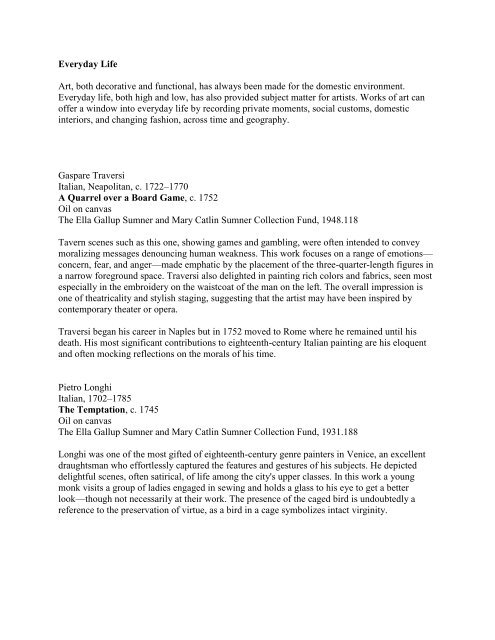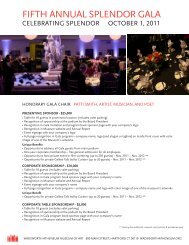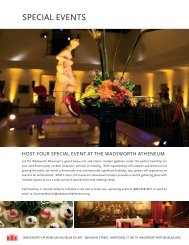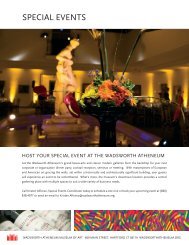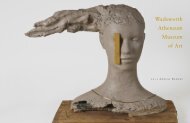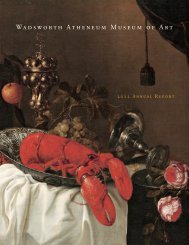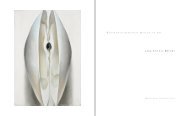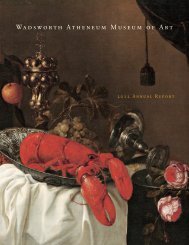The Age of Pleasure and Enlightenment European art of the ...
The Age of Pleasure and Enlightenment European art of the ...
The Age of Pleasure and Enlightenment European art of the ...
Create successful ePaper yourself
Turn your PDF publications into a flip-book with our unique Google optimized e-Paper software.
Everyday LifeArt, both decorative <strong>and</strong> functional, has always been made for <strong>the</strong> domestic environment.Everyday life, both high <strong>and</strong> low, has also provided subject matter for <strong>art</strong>ists. Works <strong>of</strong> <strong>art</strong> can<strong>of</strong>fer a window into everyday life by recording private moments, social customs, domesticinteriors, <strong>and</strong> changing fashion, across time <strong>and</strong> geography.Gaspare TraversiItalian, Neapolitan, c. 1722–1770A Quarrel over a Board Game, c. 1752Oil on canvas<strong>The</strong> Ella Gallup Sumner <strong>and</strong> Mary Catlin Sumner Collection Fund, 1948.118Tavern scenes such as this one, showing games <strong>and</strong> gambling, were <strong>of</strong>ten intended to conveymoralizing messages denouncing human weakness. This work focuses on a range <strong>of</strong> emotions—concern, fear, <strong>and</strong> anger—made emphatic by <strong>the</strong> placement <strong>of</strong> <strong>the</strong> three-qu<strong>art</strong>er-length figures ina narrow foreground space. Traversi also delighted in painting rich colors <strong>and</strong> fabrics, seen mostespecially in <strong>the</strong> embroidery on <strong>the</strong> waistcoat <strong>of</strong> <strong>the</strong> man on <strong>the</strong> left. <strong>The</strong> overall impression isone <strong>of</strong> <strong>the</strong>atricality <strong>and</strong> stylish staging, suggesting that <strong>the</strong> <strong>art</strong>ist may have been inspired bycontemporary <strong>the</strong>ater or opera.Traversi began his career in Naples but in 1752 moved to Rome where he remained until hisdeath. His most significant contributions to eighteenth-century Italian painting are his eloquent<strong>and</strong> <strong>of</strong>ten mocking reflections on <strong>the</strong> morals <strong>of</strong> his time.Pietro LonghiItalian, 1702–1785<strong>The</strong> Temptation, c. 1745Oil on canvas<strong>The</strong> Ella Gallup Sumner <strong>and</strong> Mary Catlin Sumner Collection Fund, 1931.188Longhi was one <strong>of</strong> <strong>the</strong> most gifted <strong>of</strong> eighteenth-century genre painters in Venice, an excellentdraughtsman who effortlessly captured <strong>the</strong> features <strong>and</strong> gestures <strong>of</strong> his subjects. He depicteddelightful scenes, <strong>of</strong>ten satirical, <strong>of</strong> life among <strong>the</strong> city's upper classes. In this work a youngmonk visits a group <strong>of</strong> ladies engaged in sewing <strong>and</strong> holds a glass to his eye to get a betterlook—though not necessarily at <strong>the</strong>ir work. <strong>The</strong> presence <strong>of</strong> <strong>the</strong> caged bird is undoubtedly areference to <strong>the</strong> preservation <strong>of</strong> virtue, as a bird in a cage symbolizes intact virginity.


